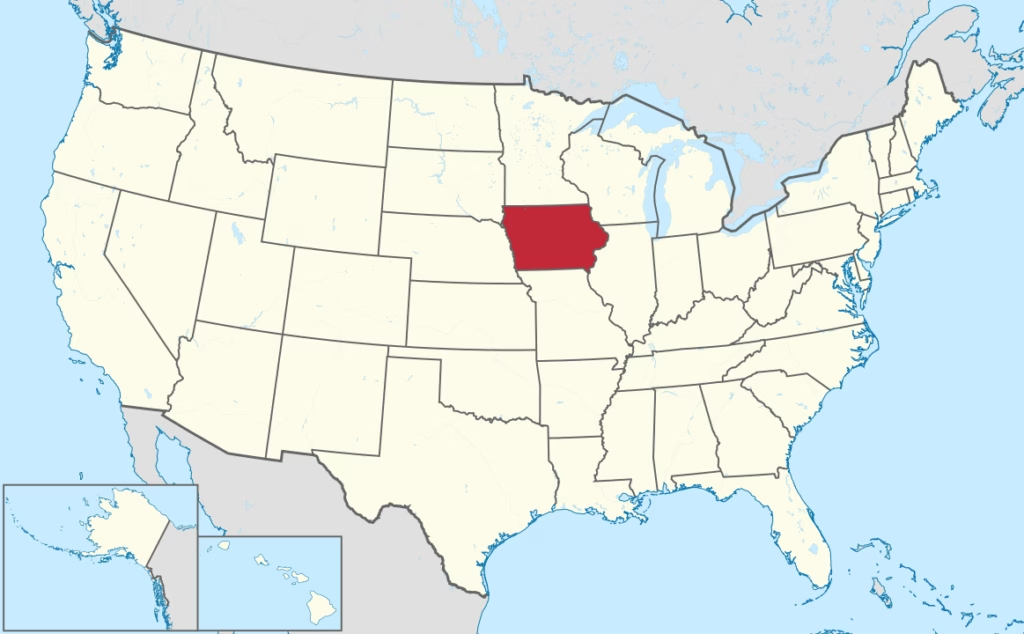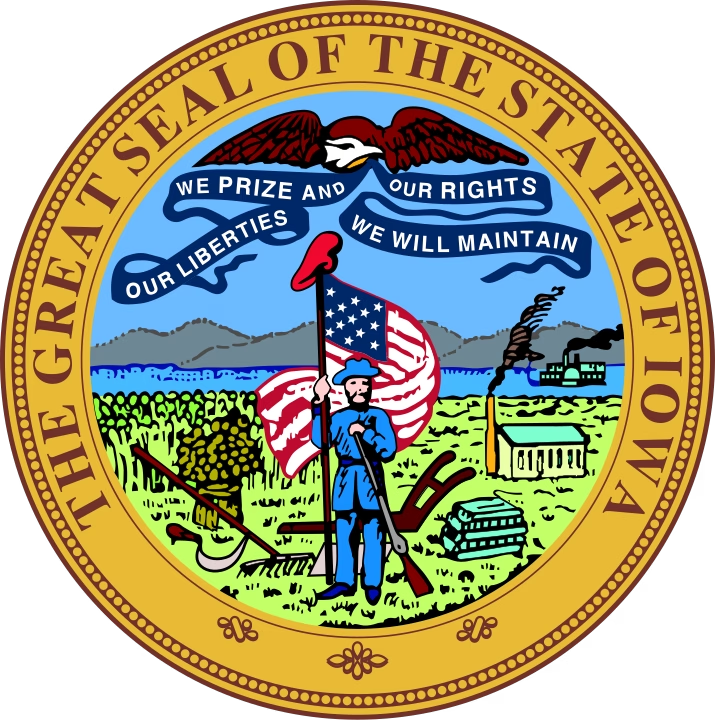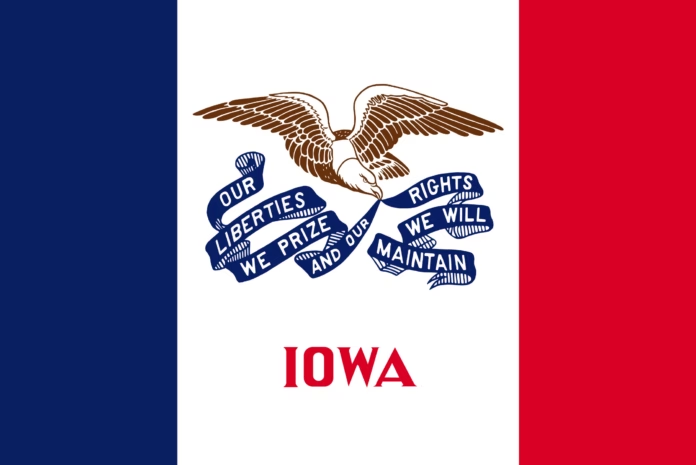Iowa, known as The Hawkeye State, is located in the heart of the American Midwest. It is celebrated for its rich agricultural heritage, strong communities, and important role in U.S. politics. For high school students studying U.S. geography and history, Iowa offers a fascinating case study of how land, culture, and industry shape a state’s identity.
Geographic Location and Physical Features
Iowa is bordered by six states: Minnesota to the north, Wisconsin and Illinois to the east (across the Mississippi River), Missouri to the south, and Nebraska and South Dakota to the west (across the Missouri River). Covering about 56,300 square miles, Iowa ranks as the 26th largest state in the U.S.
The state’s geography is largely made up of rolling plains and fertile farmland. The eastern border follows the Mississippi River, while the western border is defined by the Missouri River. These rivers have historically been vital for transportation, trade, and agriculture.
Iowa’s landscape was shaped by glaciers during the last Ice Age, creating some of the richest soils in the world. This has made it one of the most productive farming regions in the country.
A Brief History of Iowa
Native American Tribes
Long before European settlers arrived, the land that is now Iowa was home to Native American tribes such as the Ioway, Sauk, Meskwaki (Fox), and Sioux. These tribes engaged in hunting, fishing, farming, and trading.
European Exploration and Settlement
French explorers reached Iowa in the late 1600s. The territory later came under Spanish control before being returned to France, and finally sold to the United States as part of the Louisiana Purchase in 1803.
Territorial Development and Statehood
Iowa was part of the Louisiana Territory, then the Missouri Territory, before becoming its own territory in 1838. It joined the Union as the 29th state on December 28, 1846.
Iowa State Symbols and Facts
- State Nickname: The Hawkeye State
- State Capital: Des Moines
- State Bird: Eastern Goldfinch (American Goldfinch)
- State Flower: Wild Prairie Rose
- State Tree: Bur Oak
- State Motto: “Our liberties we prize and our rights we will maintain”
The nickname “Hawkeye” is believed to honor Chief Black Hawk, a Native American leader of the Sauk tribe.
Population and Demographics
Iowa has a population of approximately 3.2 million people. Most residents live in small towns and rural areas, but the state also has several metropolitan regions, including Des Moines, Cedar Rapids, and Davenport.
The population is predominantly white (non-Hispanic), with growing Hispanic, African American, and Asian communities. Iowa is known for its strong community ties, low crime rates, and high quality of life.
Des Moines: The Capital and Economic Hub
Des Moines is Iowa’s capital and largest city. It is a major center for insurance, finance, publishing, and manufacturing. The city is also known for hosting the Iowa Caucuses, the first major event in the U.S. presidential election process, making Iowa a focal point of national politics every four years.
Cultural highlights of Des Moines include:
- Pappajohn Sculpture Park
- Iowa State Capitol with its gold dome
- Des Moines Art Center
- Greater Des Moines Botanical Garden
Economy of Iowa
Agriculture
Agriculture is the backbone of Iowa’s economy. The state ranks first in the nation in corn and pork production and is also a leading producer of soybeans, eggs, and beef. Livestock farming and grain production dominate rural Iowa.
Manufacturing
While agriculture remains vital, manufacturing is also a significant sector. Iowa produces agricultural equipment, processed foods, chemicals, and machinery.
Renewable Energy
Iowa is a national leader in wind energy production, generating over 60% of its electricity from wind power. The state is also involved in biofuel production, particularly ethanol from corn.
Education and Higher Learning in Iowa
Iowa has a strong commitment to education, consistently ranking high in literacy rates and educational quality.
Notable universities and colleges include:
- University of Iowa – Known for its writing programs and research.
- Iowa State University – Renowned for agriculture, engineering, and veterinary medicine.
- Drake University – Known for law, business, and journalism programs.
- Grinnell College – A prestigious liberal arts college.
Culture and Arts in Iowa
Iowa’s culture blends Midwestern traditions, agricultural heritage, and immigrant influences. The state has produced notable figures such as Herbert Hoover (31st U.S. President), actor John Wayne, and author Bill Bryson.
Iowa is home to many festivals and events:
- Iowa State Fair – One of the largest state fairs in the U.S., known for livestock shows, entertainment, and unique food.
- Tulip Time Festival in Pella – Celebrating Dutch heritage.
- RAGBRAI – A week-long bicycle ride across the state.
Music, theater, and art thrive in Iowa’s cities and college towns, while rural communities preserve folk traditions.
Tourism and Natural Attractions
Iowa offers a variety of natural and historical attractions:
- Effigy Mounds National Monument – Preserves prehistoric Native American burial mounds shaped like animals.
- Maquoketa Caves State Park – Features caves, trails, and unique rock formations.
- Amana Colonies – A group of historic German settlements known for traditional crafts and food.
- Mississippi River towns – Offering scenic views and cultural heritage.
Interesting Facts About Iowa
- Iowa is the only U.S. state bordered by two navigable rivers (Mississippi and Missouri).
- The Iowa State Fair inspired scenes in movies and literature.
- Slipknot, a globally known metal band, originated in Des Moines.
- The state’s soil is among the most fertile in the world, perfect for farming.
- The Field of Dreams baseball movie site is in Dyersville, Iowa.
Why Study Iowa?
For students, Iowa offers lessons in geography, agriculture, politics, and community life. Its role in presidential elections through the Iowa Caucuses makes it politically significant. Its agricultural success story teaches the importance of natural resources, technology, and innovation in food production.
Iowa, The Hawkeye State, stands as a symbol of Midwestern resilience and productivity. From its fertile farmlands and renewable energy leadership to its cultural heritage and political importance, Iowa plays a unique role in the story of the United States. High school students studying Iowa will not only learn about a state—they will gain insight into the agricultural, economic, and political forces that shape the nation.



